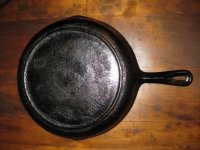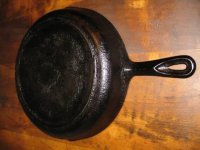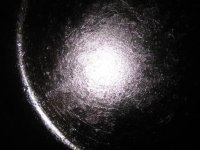I purchased a few CI skillets with all kinds of crud on the outside and the inside is typically smooth and shiny.
I love this condition because, IMHO, this condition depicts the old timey usage and history of the cookware. BUT, I do not feel comfortable cooking in it because I feel the surface might be painted. So, I just cleaned and re-seasoned several of my purchases for this reason.
I would like to use the cookware as is but I feel I must be confident it isn't paint.
How does one know if the cookware is painted or just coated in loving history?
The third photo is a close up of the actual cooking surface.
I love this condition because, IMHO, this condition depicts the old timey usage and history of the cookware. BUT, I do not feel comfortable cooking in it because I feel the surface might be painted. So, I just cleaned and re-seasoned several of my purchases for this reason.
I would like to use the cookware as is but I feel I must be confident it isn't paint.
How does one know if the cookware is painted or just coated in loving history?
The third photo is a close up of the actual cooking surface.



